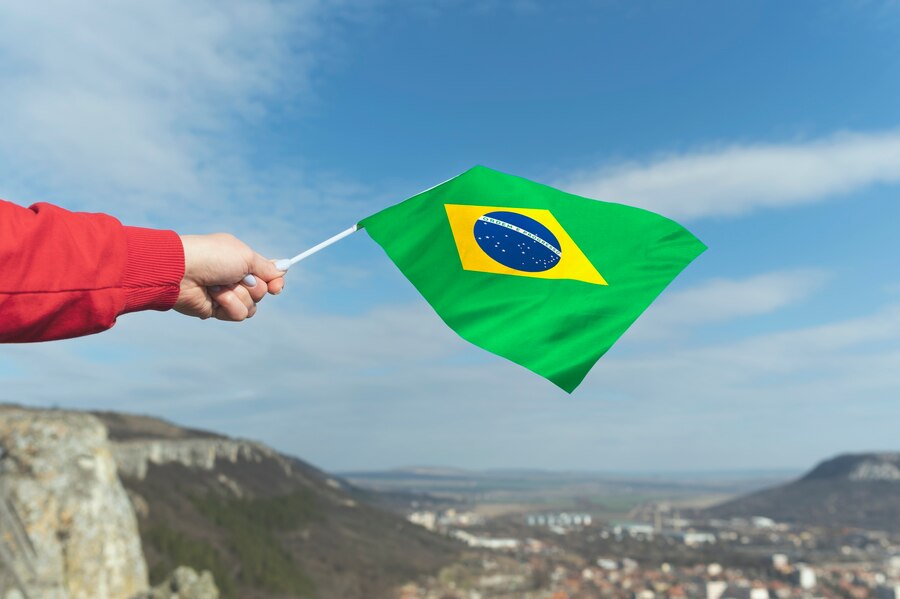National flags are powerful symbols, embodying the history, culture, and identity of a country. The Brazil flag is no exception. Known for its vibrant colors and distinctive design, it is a symbol that resonates deeply with Brazilians and is recognized worldwide. But what is the story behind this iconic flag? Let’s dive in and explore the rich history and significance of the Brazil flag.
Historical Background
Before Brazil became an independent nation, it was a colony of Portugal. During this period, the flags used in the region were variations of the Portuguese flag. The journey towards a unique national flag began with Brazil’s independence on September 7, 1822.
The first flag of independent Brazil was designed with inspiration from the imperial family of Portugal. This flag featured a green field with a yellow diamond at the center, incorporating elements of the House of Braganza (green) and the House of Habsburg (yellow).
Symbolism and Meaning
The Brazil flag is rich in symbolism, each element representing a piece of the nation’s identity:
The Green Field
The green background symbolizes Brazil’s lush forests and natural wealth. It also honors the heritage of the Braganza family.
The Yellow Diamond
The yellow diamond represents the abundance of Brazil’s mineral resources, especially gold, reflecting the country’s vast wealth and potential.
The Blue Globe and Stars
At the heart of the flag lies a blue globe with 27 white stars arranged to mirror the night sky over Rio de Janeiro as it appeared on November 15, 1889, the day Brazil became a republic. Each star represents a Brazilian state and the Federal District, symbolizing the unity of the nation.
The National Motto
The banner across the globe reads “Ordem e Progresso” (“Order and Progress”), a motto inspired by the positivist philosophy of Auguste Comte, emphasizing the importance of order for progress and societal improvement.
Design Evolution
The Brazil flag has undergone several changes since its inception:
Changes from the Imperial Flag
The original design of the imperial flag included elements representing the monarchy. When Brazil transitioned to a republic in 1889, the flag was modified to reflect its new political status. The crown was replaced with a blue globe, and the positivist motto was added.
Modern Adaptations
Over the years, minor adjustments have been made to the flag to include new states as they were created. The current version includes 27 stars, accurately representing all the states and the Federal District.
Cultural Significance
The Brazil flag is more than just a national symbol; it is woven into the fabric of Brazilian culture. It is a common sight at festivals, sports events, and public celebrations. The flag’s colors and design are widely used in art, fashion, and media, showcasing the nation’s pride and unity.
Flag Etiquette and Usage
There are specific guidelines for displaying the Brazil flag, ensuring it is treated with the respect it deserves:
Official Guidelines
The Brazilian government has established protocols for the flag’s use, including when and where it should be flown, how it should be folded, and the appropriate times for hoisting and lowering it.
Common Practices
In everyday life, the flag is often displayed during national holidays, sporting events, and political gatherings. It is also a common decoration in homes and businesses, symbolizing patriotism and national pride.
Comparison with Other National Flags
The Brazil flag stands out due to its unique design and symbolism. Unlike many flags that feature simple tricolors or straightforward patterns, the Brazil flag’s intricate design sets it apart.
Unique Features
The use of a celestial globe and a detailed star map is rare among national flags, making Brazil’s flag particularly distinctive.
Similarities and Differences
While the colors green and yellow are used by other nations (like Jamaica and Lithuania), Brazil’s specific shade and combination, along with the blue globe, create a unique identity.
Common Misconceptions
There are several myths surrounding the Brazil flag that are worth debunking:
Myths about the Design and Colors
One common misconception is that the green and yellow represent Brazil’s lush landscapes and mineral wealth exclusively. While this is partly true, the colors also honor the royal heritage.
Clarifying False Information
Another myth is that the stars on the flag correspond to the states by geographic location. In reality, the stars represent constellations as seen from Rio de Janeiro.
The Flag in Sports
Brazil’s flag plays a significant role in the world of sports, particularly in football (soccer):
Brazil Flag in International Sports
The flag is a ubiquitous sight at international competitions, proudly displayed by fans and athletes alike. It symbolizes national pride and the spirit of the Brazilian people.
Symbolism in Football (Soccer)
Football, being a national passion, sees the flag prominently featured in stadiums, jerseys, and merchandise. The flag’s presence at matches embodies the unity and fervor of Brazilian supporters.
Flag Day and Celebrations
Brazil has a dedicated Flag Day, celebrated annually on November 19th:
National Observances
On this day, various ceremonies are held across the country, including the hoisting of the flag and patriotic speeches.
How Brazilians Celebrate Their Flag
Schools, government buildings, and public spaces are adorned with the flag. Many Brazilians also participate in parades and educational events to honor the flag’s significance.
International Influence
The Brazil flag is not just a national symbol; it has global recognition and influence:
Global Recognition
The flag is instantly recognizable around the world, often associated with Brazil’s vibrant culture and achievements.
Influence on Other Countries’ Flags
While direct influence on other flags is limited, Brazil’s unique design has inspired various artistic and cultural representations globally.
Flag Manufacturing
Creating a Brazil flag involves precise manufacturing processes to ensure accuracy:
How the Flag is Made
Flags are typically made from durable materials like nylon or polyester to withstand outdoor conditions. The intricate design requires careful printing or embroidery.
Materials and Production Process
Manufacturers follow strict guidelines to ensure the correct color shades and proportions. The production process includes cutting, printing, sewing, and quality checks.
Preservation and Respect
Proper care and handling of the Brazil flag are essential to maintaining its dignity:
How to Properly Care for the Flag
Flags should be cleaned regularly and stored in a dry place to prevent damage. Faded or tattered flags should be replaced to maintain respect for the symbol.
Legal Aspects of Flag Desecration
Brazilian law outlines penalties for desecrating the flag, emphasizing its importance as a national symbol. Respecting the flag is seen as respecting the country itself.
Interesting Facts
Here are some fun and lesser-known details about the Brazil flag:
Fun Trivia about the Brazil Flag

The flag’s design was created by a group of Brazilian intellectuals and the French painter Jean-Baptiste Debret.
The stars on the flag represent the constellations of the Southern Hemisphere.
Lesser-Known Details
The specific star configuration on the flag replicates the sky over Rio de Janeiro on the night Brazil became a republic.
The flag has inspired numerous songs, poems, and artworks in Brazilian culture.
Conclusion
The Brazil flag is a vibrant symbol of the nation’s history, culture, and values. Its unique design and rich symbolism make it a powerful representation of Brazil’s identity. Whether fluttering at a sports event or displayed proudly on a national holiday, the Brazil flag continues to inspire pride and unity among its people.
FAQs
What do the colors of the Brazil flag represent?
The green represents Brazil’s forests, the yellow symbolizes its mineral wealth, and the blue globe with stars reflects the night sky over Rio de Janeiro.
When was the current Brazil flag adopted?
The current design was adopted on November 19, 1889, following Brazil’s transition from an empire to a republic.
How is the Brazil flag used in international events?
The flag is prominently displayed at international events, especially in sports like football, symbolizing national pride and identity.
Are there any specific rules for displaying the Brazil flag?
Yes, there are official guidelines on how to display, handle, and care for the flag, including appropriate times and manners for hoisting and lowering it.
What is the significance of the stars on the Brazil flag?
The stars represent the constellations visible over Rio de Janeiro on the night of November 15, 1889, each corresponding to a Brazilian state and the Federal District.
